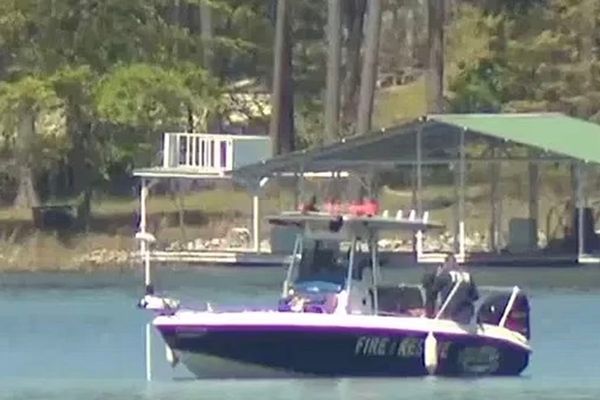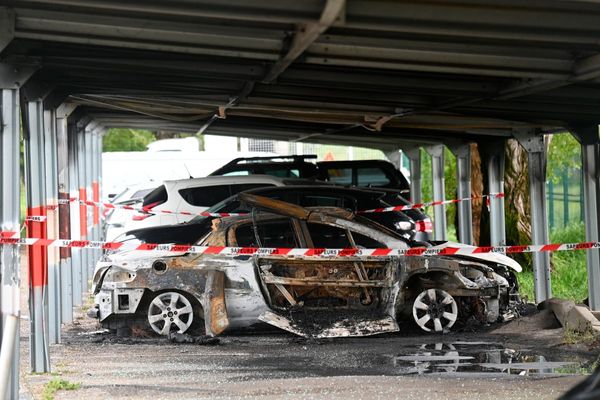It’s hard to picture what Barnardsville looked like before Hurricane Helene converted the calm creek that meanders through this North Carolina mountain holler into a roaring river that engulfed the community.
More than 50 homes including an entire trailer park were destroyed when Ivy Creek flooded in late September after three days of unprecedented rainfall and hurricane-force winds uprooted thousands of trees – and this close-knit community’s sense of safety.
A few residents left after the creek subsided to reveal the scale of destruction, but most had nowhere else to go and didn’t want to leave this Bible belt town where many have generational ties. After several weeks sleeping in vehicles and tents, displaced families are now mostly living in donated RVs, sheds or tiny homes – insulated huts without plumbing constructed by volunteers who came in droves to southern Appalachia.
“The trees went snap, snap, snap. A bear came running down from the mountain. Our home, our vehicle, everything we had floated away … It was crazy and so sad to watch,” said Twila Little Brave, 47, a member of the Rosebud Sioux tribe.
Little Brave and her partner, Dustin Crabtree, are now living out of a collection of sheds on the eroded riverbank next to a badly flood-damaged house – which belongs to her brother Michael, whose entire mechanic’s shop, beehives and chicken coops floated away. They rely on expensive tanks of propane for heat and cooking, and drive to the relief centre to shower and do laundry. The couple had no insurance, and it’s going to take years to rebuild.
“We lost everything we had, but we’re really grateful to be alive. We would not have survived without the community – it’s people helping people, not the government,” said Little Brave, who works at a gas station and makes traditional jewellery. “But I do feel anxious when it rains and the river rises – the land we’re on is still moving,”
Four months on in Barnardsville, which is 20 miles (32km) north of Asheville, entire homes remain jammed lopsided in mud after being dislodged and swept away by the force of the flood water. Ivy Creek remains a menacing presence without its protective tree line – an eroded, silty riverbank cluttered with shattered bridges, overturned vehicles, upended trees, a gas pump, a hot tub and an array of household appliances.
“We’ve made sure that our people have enough food and fuel to survive the winter, but that’s the easy part. Now we have very poor people living in what are effectively lawnmower sheds and campers … and I don’t know how they will get out from there,” said David Crowder, a Baptist pastor whose church became a major relief hub in Barnardsville. “These are mountain people – they are prideful and resilient but you can feel depression setting in.”
In January, the creek flooded again after only a couple of inches of rain, leaving some families stranded away from their homes as scores of small bridges are yet to be fixed. It could be months before the electric motor manufacturer, a major local employer, reopens after its plant was condemned. The need for food aid remains high.
“It changed the landscape of the place. I’s unbelievable how many trees went down and how wide the creek is now. I am 56, and I don’t think this area will recover in my lifetime,” Crowder added.
Helene was the deadliest storm to hit the US mainland since Hurricane Katrina, two decades earlier, killing more than 220 people across six states including 103 confirmed deaths in western North Carolina and 17 in eastern Tennessee. The majority of deaths were caused by torrential rain that triggered landslides and catastrophic flooding, and by gale-force winds which toppled millions of trees. About a dozen people remain unaccounted for. Lives were lost – and ruined: tens of thousands of homes, businesses, roads and other critical infrastructure were destroyed or damaged, at a cost of almost $60bn in North Carolina alone.
The trail of destruction left behind by Helene exposed America’s growing vulnerability to the climate crisis, as well as major gaps in infrastructure resilience, insurance coverage, and local and federal government capacity to cope with increasingly destructive extreme weather events.
Yet in the mountain communities visited by the Guardian, the climate crisis was largely absent from people’s thoughts. Rather, the storm appears to have also hardened an existing sense of abandonment – the feeling that the federal government doesn’t care about Appalachia, as well as amplifying mistrust in science- and fact-based narratives.
The hurricane hit just a few weeks before the 2024 elections, and delays and deficiencies in federal assistance are mostly blamed on Joe Biden and the Democrats – even though it was a group of Republican lawmakers, egged on by Elon Musk and Donald Trump, that delayed a $100bn disaster relief package even as small businesses went under and displaced families struggled to cover repairs.
Four months on, scores of rivers, mountainsides and bridges across rural parts of east Tennessee and western North Carolina still require major engineering work to stop further erosion – and reduce the risk of future floods and landslides. Anxiety levels are high; faith in government is low.
Sharon Jarvis, 59, lives on a steep slope of a forested mountain on the outskirts of Barnardsville, where swirling winds brought down hundreds of poplar, oak, pine and maple trees.
Four large trees fell directly on top of her house – two on to her teenage daughter’s bedroom, while another came crashing into the bedroom where her brother, David, 33, who has Down’s syndrome, was sleeping. Local church members and volunteers helped remove the trees, but the damaged roof and walls need urgent repair which the house insurance payout will not cover.
“We’ve been in this house for 36 years, but there are so many loose trees that I don’t feel safe any more. My nerves are shot when it rains, with every gust of wind. If we had some place else to go, I would get off this hill,” said Jarvis, who grew up just a few miles away.
The family received $750 from the Federal Emergency Management Agency (Fema), the standard one-off payment for immediate relief, and didn’t apply for further assistance. Jarvis is hoping to receive help from an evangelical humanitarian group, otherwise she will need to borrow thousands of dollars to clear the tree branches hanging precariously above the house and replace the roof – or attempt to fix it herself. “It’s unreal how many people have come here to help, when the government didn’t help us at all. By God’s mercy we survived.”
State and federal agencies continue to work across the affected region, but much of the visible relief effort in rural communities – from sawing through fallen trees, clearing debris, distributing aid and building new homes – has been carried out by volunteers and non-profits, including prominent evangelical Christian relief groups and local churches.
“People in this region will always think about life before Hurricane Helene and after … This was southern Appalachia’s Katrina,” said Saket Soni, founder of Resilience Workforce. “The volunteer effort has been extraordinary, but to rebuild after this scale of damage you need a skilled workforce, and that’s the biggest vulnerability the region faces.”
Frustration at the government, especially Fema, is widespread even among those who have received financial help – and so are false rumors and conspiracy theories that include blaming the catastrophic floods on dam failures and deliberate weather manipulation. Other falsehoods spread online and expressed to the Guardian include persistent rumors that hundreds of people are still missing or unidentified in morgues, as well as unsubstantiated claims that child trafficking surged.
About 30 miles (48km) south of Barnardsville, the Swannanoa River burst its banks, sweeping homes and businesses off their foundations. Four months on, the area still looks like a war zone, with trees, broken buildings and crushed vehicles piled high along the eroded riverbank and Highway 70. At one motel, it feels as if time stood still: cars are still parked outside the rooms, doors open and flanked by mud-coated toys, clothes and air conditioning units. Fema dump trucks are still collecting debris, but relatively little progress has been made compared with the cleanup in nearby Asheville.
It was the town of Swannanoa that Trump chose to visit during his second week in office, and muse about potentially dismantling Fema. Trump spoke just meters away from where Michael “Lewis Arthur” Meyer, founder of a Christian nationalist militia group from Arizona, has set up camp with a group of supporters, and is spreading baseless conspiracies about the US military intentionally causing Helene in order to orchestrate land grabs and obtain mineral rights from affected locals.
“This is part of the US weather weaponization project to generate an intentional storm … a land grab by the military who couldn’t storm in directly because these Appalachian boys know how to use guns,” Meyer told the Guardian as one of his supporters filmed, claiming to be a journalist.
There has been a notable uptick in rightwing and fossil fuel-friendly conspiracy theorists spreading falsehoods in the wake of recent climate-fueled disasters especially in the US. The disinformation appears to resonate among even those directly hit by floods and fires, as people are bombarded with false messaging designed to sow doubt, according to Sean Buchan, research director at Climate Action Against Disinformation.
“Without all the disinformation, climate disasters should be a lightbulb moment that led to a lot more people taking action. But when fossil fuel networks are sowing so much doubt and these falsehoods are amplified online by big tech, people can’t believe anything … And because climate science is complicated and nuanced and requires patience, the propagandists and bad actors will show up in person or online to fill the information vacuum,” said Buchan.
The Guardian spoke with two dozen or so people in mountain communities who were directly affected by Helene and volunteers who are helping them rebuild. Carl Ponder, 66, a retired factory manager whose family lost their trailer in Barnardsville, was the only one who believed human-made global heating played a role in the devastation caused by the storm. “Of course climate change made it worse … Trump’s not going to help us, he just cares about billionaires,” he said.
Many have found comfort from attributing Helene to God’s will and said Mother Nature cannot be controlled. “This was a thousand-year flood,” said Little Brave.
But the science is clear: the intensity of the wind and rain during Helene was supercharged by the climate crisis, and the frequency and severity of such storms will increase as the planet continues to warm – driven by the world’s dependence on the burning of fossil fuels. President Biden oversaw record oil and gas production, which President Trump has vowed to expand.
Yet several people expressed faith in life improving under Trump, and that his promise of deregulation will allow them to build back more quickly – even though many flooded riverbanks may no longer be safe. Most appear unfazed by Trump’s threats to dismantle Fema and the National Oceanic and Atmospheric Administration (Noaa), which provides weather forecasts and storm and tornado warnings, and monitors climate trends.
“We’re more hopeful with Trump, at least he is a God-fearing man and anything he does will be more than we had from the last administration,” said David Carson, 75, a landowner in Barnardsville who said he received more than $40,000 from Fema that will partially cover repairs to his property. (Biden is a lifelong devout Catholic; Trump identifies as a Presbyterian and has forged close relationships with evangelical leaders during his presidential campaigns.)
One resident, a climate expert to whom the Guardian spoke, put the disaster in scientific context.
“I have a 20ft stack of scientific papers and reports dating back to 1992 which consistently show that as the planet continues to warm, these events will become more intense and stronger. But somehow we’ve failed to communicate this in a way that reaches some of the most vulnerable people, while they’re getting false information from places they trust,” said Thomas Karl, a climatologist and former head of Noaa’s National Center for Environmental Information in Asheville.
“The reassurances people are giving themselves are based on flooding that their parents and grandparents experienced, and this is a false sense of security.”
In the long term, rebuilding rural communities will be hard: few if any households had flood insurance, and volunteers and donations are dwindling. Restoration, demolition and reconstruction work has been slowed by frigid temperatures and a lack of skilled workers.
About 30 miles north of Barnardsville is Erwin, Tennessee. The town’s only hospital, which opened in 2018, remains closed indefinitely due to flood damage – after dozens of patients and staff were airlifted from the roof by the national guard in Black Hawk helicopters. There are vast empty lots and piles of debris where homes, churches, businesses and factories along the bends of the snaking, flood-prone Nolichucky River were inundated or swept away entirely. A plastics plant is facing legal action and a state investigation after six factory workers drowned, including Rosa Andrade, 29, whose body was found 33 days later. (Impact Plastics denies any wrongdoing.) The bodies of several missing North Carolina residents were also found in Erwin, washed miles downstream by fast-moving flood water.
“The damage around Erwin was apocalyptic,” said Ryan Thigpen, an earth and environmental sciences professor at the University of Kentucky who researches flooding in the region. “The next storm may come before they are finished recovering from this.”
The main road connecting Erwin to Bumpus Cove, a small riverside community, is still closed due to flood damage, and the reroute has increased the commute from 12 to 35 minutes. At least 10 houses along the riverfront collapsed or were entirely swept away; another dozen or so situated on the other side of the road were also severely damaged and later condemned.
In one case, four generations of the same family all lost their homes. Patsy White, 84, her daughter Rhonda Mango, 55, and her granddaughter Megan Milhorn, 29, all grew up here – with Milhorn raising two small children of her own – and had never lived anywhere else until the river flooded on 27 September. The last big flood was in 1977, but even then the water barely touched White’s house, which was set farthest back from the river. As the water rose in September, they moved some valued possessions into White’s house, leaving with only a change of clothes and a few toys. “We thought we’d be back the next day to clean up the mud and get on with our lives,” said Milhorn.
Mango’s and Milhorn’s homes floated away, along with their vehicles; White’s house collapsed shortly after. There isn’t a single photograph, marriage certificate, kid’s painting or any other memento left. The family Bible, which had been passed down through several generations, is gone. They are now living in camper vans a few miles away.
“This is the only place I know … It’s still hard to believe that it’s all gone. They call it a 500-year flood, so I will probably never see another like this,” said Milhorn. “Fema is a complete joke … The church has been helping us, but everything is so slow. They’ve not started building yet, it’s depressing.”
None of the family had flood insurance. They all received $11,000 or so from Fema to cover some lost contents. White and Mango also qualified for Fema’s maximum homeowner payout, $42,500, which they gave to the Appalachia Service Project, a Tennessee-based Christian ministry and housing charity which, according to its website, is raising funds to rebuild or repair 200 homes damaged by Helene. (Milhorn did not receive Fema funds, as her home was built on her grandmother’s plot without a separate deed.)
The Appalachia Service Project will build two mortgage-free houses for them a few miles away, on land purchased by the Evergreen church in Erwin, but the group relies on volunteer workers and it is unclear how long this will take.
“You can’t imagine how pretty it was … I feel so sad,” said White, tearing up as she looked across the eroded empty lots strewn with debris and trash. “I don’t even have a photo of my husband who died. I dream about coming back – this is all I know – but I don’t think it will happen. Life won’t be the same again.”
The Guardian receives support for visual climate coverage from the Outrider Foundation. The Guardian’s coverage is editorially independent.







